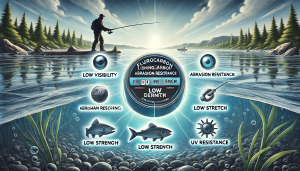Currently Empty: $0.00

Fluorocarbon fishing line has become a go-to choice for many anglers due to its unique properties and advantages. This guide will delve into what fluorocarbon line is, its benefits, drawbacks, and best use cases. Understanding these aspects will help you make informed decisions for your fishing needs.
What is Fluorocarbon Line?
Fluorocarbon line is made from polyvinylidene fluoride, a type of plastic that offers several unique advantages over other fishing lines. This material is nearly invisible underwater, making it a top choice for fishing in clear waters. The line’s low visibility can significantly increase your chances of getting bites, as fish are less likely to detect it.
Benefits of Fluorocarbon Line
- Invisibility Underwater: One of the standout features of fluorocarbon line is its ability to blend seamlessly into the water. This property is crucial when targeting skittish fish in clear conditions. The near-invisibility of the line can make a significant difference in your fishing success.
- Abrasion Resistance: Fluorocarbon line is known for its toughness and durability. It can withstand contact with rocks, logs, and other underwater structures better than many other types of line. This makes it an excellent choice for fishing in areas with rough terrain.
- Density and Sinking Properties: The higher density of fluorocarbon line allows it to sink faster than monofilament. This can be particularly advantageous when fishing with lures or baits that need to reach the bottom quickly. The sinking property also helps in maintaining better control.
- Sensitivity and Low Stretch: Fluorocarbon line has minimal stretch, which translates to better sensitivity. Anglers can detect even the slightest bites, which is essential when fishing for species that are known for their light bites. This increased sensitivity can lead to higher catch rates.
Drawbacks of Fluorocarbon Line
- Stiffness: Compared to monofilament, fluorocarbon line is stiffer and can be more challenging to handle, especially for beginners. This stiffness can make casting and knot tying more difficult, but with practice, these challenges can be overcome.
- Cost: Fluorocarbon line is generally more expensive than other types of fishing lines. This higher cost is due to the advanced manufacturing process and superior materials used. However, many anglers find the benefits worth the investment.
Choosing the Right Fluorocarbon Line
Fluorocarbon line comes in various strengths and diameters, making it suitable for a wide range of fishing applications. When selecting fluorocarbon line, consider the type of fish you’re targeting and the fishing conditions. Heavier lines are ideal for larger fish and rougher conditions, while lighter lines work well for smaller fish and clear waters.
Using Fluorocarbon as Leader Material
Many anglers prefer using fluorocarbon as a leader material rather than spooling their entire reel with it. This approach combines the invisibility and abrasion resistance of fluorocarbon with the manageability of other line types like braided line for spinning reels. Fluorocarbon leaders can enhance your fishing setup without the need for a full spool of fluorocarbon.
Knots and Fluorocarbon Line
Knot strength is a crucial factor when using fluorocarbon line. Properly tied knots in fluorocarbon are strong and reliable, reducing the chances of the line slipping or breaking. Learning the right knot-tying techniques can maximize the line’s performance and ensure your setup is secure.
UV Resistance and Longevity
Fluorocarbon line exhibits excellent resistance to UV rays. Unlike some other types of fishing line that degrade when exposed to sunlight, fluorocarbon maintains its strength and performance over time. This UV resistance contributes to the line’s longevity, making it a cost-effective choice in the long run.
Conclusion
Fluorocarbon line is a versatile and valuable tool for anglers, offering unique advantages such as invisibility, abrasion resistance, and sensitivity. While it may come with a higher cost and some handling challenges, the benefits it provides can significantly improve your fishing experience. By understanding its properties and best use cases, you can make the most of fluorocarbon line in your fishing adventures.


